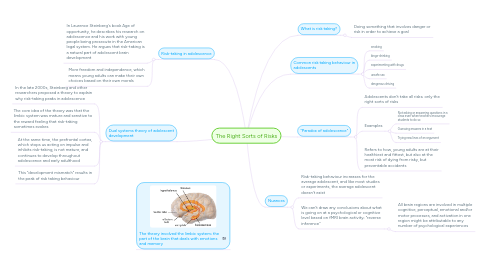The Right Sorts of Risks
by Kaustav Sahoo


1. The theory involved the limbic system; the part of the brain that deals with emotions and memory
2. Risk-taking in adolescence
2.1. In Laurence Steinberg's book Age of opportunity, he describes his research on adolescence and his work with young people being prosecute in the American legal system. He argues that risk-taking is a natural part of adolescent brain development
2.2. More freedom and independence, which means young adults can make their own choices based on their own morals
3. Dual systems theory of adolescent development
3.1. In the late 2000s, Steinberg and other researchers proposed a theory to explain why risk-taking peaks in adolescence
3.2. The core idea of the theory was that the limbic system was mature and senstive to the reward feeling that risk-taking sometimes evokes
3.3. At the same time, the prefrontal cortex, which stops us acting on impulse and inhibits risk-taking, is not mature, and continues to develop throughout adolescence and early adulthood
3.4. This "development mismatch" results in the peak of risk taking behaviour
4. "Paradox of adolescence"
4.1. Adolescents don't take all risks; only the right sorts of risks
4.2. Examples
4.2.1. Not asking or answering questions in a class even when teachers encourage students to do so
4.2.2. Guessing answers in a test
4.2.3. Trying new lines of an argument
4.3. Refers to how, young adults are at their healthiest and fittest, but also at the most risk of dying from risky, but preventable accidents
5. What is risk taking?
5.1. Doing something that involves danger or risk in order to achieve a goal
6. Common risk taking behaviour in adolescents
6.1. smoking
6.2. binge-drinking
6.3. experimenting with drugs
6.4. unsafe sex
6.5. dangerous driving
7. Nuances
7.1. Risk-taking behaviour increases for the average adolescent, and like most studies or experiments, the average adolescent doesn't exist
7.2. We can't draw any conclusions about what is going on at a psychological or cognitive level based on fMRI brain activity; "reverse inference"
7.2.1. All brain regions are involved in multiple cognitive, perceptual, emotional and/or motor processes, and activation in one region might be attributable to any number of psychological experiences
